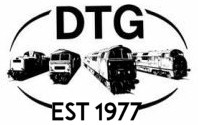Restoration Works
D7029 was stopped after the 23rd of July 1987 at the NYMR. The loco required tyre turning and the air reservoirs re-certified. Commitments in getting D1015 running, coupled with the long journey times from our London base to Yorkshire meant these items did not get done and D7029 was mothballed and stored at Grosmont.
D7029 didn't move again until December 1995, when it was hauled to Pickering ready for road movement to the Severn Valley Railway. D7029 arrived at Kidderminster by road on the 26th March 1996 after a two day trip. Stored immediately in a siding we later approached EWS and secured accommodation at Old Oak Common, the then home of D1015 and much nearer to our engineers and volunteers.
D7029 went by road to Old Oak Common on the 9th May 2000 where work could get underway, although by this time with 13 years in storage, it was decided to gut the loco completely and undertake a full restoration. In August 2005, D7029 moved to the Severn Valley Railway where it remains with work still ongoing.
2000-2005
With D1015 fit for mainline trials and later certified, D7029 was eventually able to move in to Champion's place in The Factory and this move was actually performed by D1015. One of the first jobs was to remove the roof sections and take out the boiler water tanks, cooler group, dynostarter, transmission and engine. This left a very dirty, but empty, shell.
All of the old wiring was removed and the A end cab then gutted to allow structural repair of the cab frame and body skins, or what was left of them! Whilst body cleaning and repairs continued the major components went off to our Birmingham workshop for overhaul.
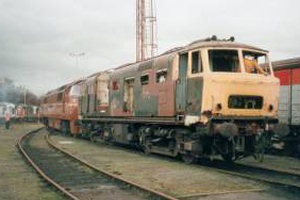 |
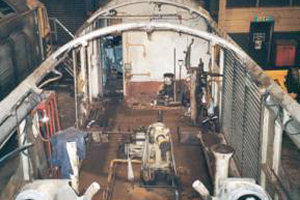 |
|
Western Champion shunts D7029 into the factory to occupy the space where D1015 stood |
An empty D7029 with power unit, transmission, cooler group, dynostarter, boiler water tanks
and other machines removed |
Over the ensuing months we gradually emptied the Hymek body and stripped out the A end cab until it was completely and utterly bare. One of the major jobs will be body replating which, although relatively easy, is vastly time consuming and will form a major portion of the expected 20,000+ man hours required to return Hymek D7029 to traffic.
Collision Damage Repairs
During March 1970, D7029 sustained collision damage. The details are not known other than it occurred on or near to the
16th March working 8A02/7, however, what appears to have happened is that the locomotive was 'sandwiched' between two
other vehicles. The 'B' end cab and main frames were forced downwards and the 'A' end cab received front end damage
above bufferbeam level.
Whilst Swindon completely stripped, reshaped and rebuilt the 'B' end cab, the 'A' end had the minimum amount done to return the locomotive to service as quickly, and as cheaply, as possible. Rather than square up parts of the superstructure they simply added new cab side sheets that were bigger to cover the sides to the cab doors!
Since we have had the Hymek the 'A' end cab doors have never closed properly and the cab sides have suffered badly from corrosion. Having stripped down the cab we now know why! The incorrect gauge sheet steel had been used on the cab sides by Swindon (16 gauge rather than 10, thinner steel being easier to work with and form into shapes) and we have found a cab door pillar to be ½ an inch out of 'true'.
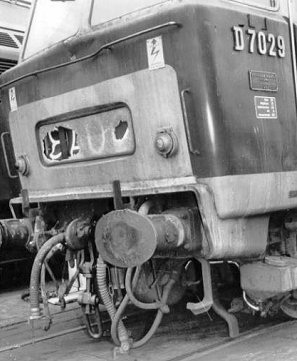 This official photograph was kept in the maintenance folder for D7029 held by Swindon Works and given to us
with the locomotive.
This official photograph was kept in the maintenance folder for D7029 held by Swindon Works and given to us
with the locomotive.
The records in the folder show the collision force had closed the door apertures of 'A' cab by 1½ inches, the cab doors could not be closed and the cabside window frames were also distorted. Nose end dents and smashed route indicator glass are also clearly visible in the photo. The recommendation was that both cabs should be removed for the work to be carried out. Only the 'B' cab was removed, 'A' cab was repaired in situe which resulted in the cab side door apertures being pulled open, but opened too much by a ½ inch. 'B' end generally sustained the worst damage with both buffers being forced downwards by some 6 inches. |
Rather than just replace the cab sheets and live with the defect, as British Railways did for five years, we have decided to correct the defect and replace the cab sheets using the correct gauge steel. In order to achieve this we have had to completely strip the A end cab and remove everything!
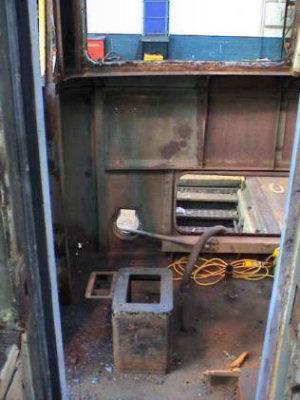
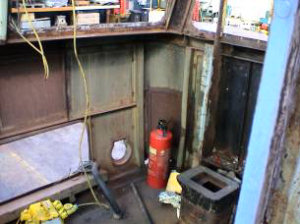 'A' cab stripped out ready for work to be carried out on the cab superstructure and cab side sheets.
'A' cab stripped out ready for work to be carried out on the cab superstructure and cab side sheets.
The two 'new' rusty sections below the cab windscreen centre pillar were fitted at Swindon to take out the dent in the nose end centre. |
It will probably take a year or more to sort out the cab door frames in the 'A' end cab and prepare the superstructure for re-sheeting. Luckily we have numerous drawings, saved from Swindon on micro-fish, and official books detailing exactly how to do the work. All this work, time, money and effort to correct a defect measuring ½ inch!
With the engineers busy on the 'A' cab there is plenty to do around the rest of the loco, cleaning the engine room, boiler room and cooler group compartments.
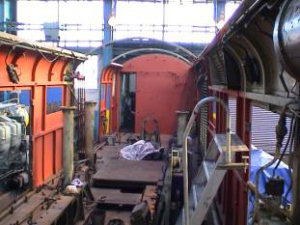 |
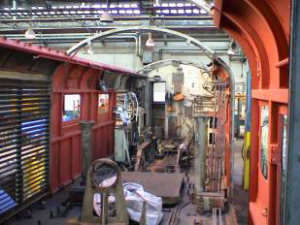 |
|
Looking from B cab towards A cab. The pillars in the middle of the loco support the water tank supplying the train
heating boiler fitted above the transmission (removed). The frames supporting the MD 870 engine are in the foreground. |
Looking from A cab towards B cab. The stand in the foreground with the circular hole is the frame for the Serck cooling fan
pump, driven from a cardan shaft from the transmission. Next to this is where the dynostarter sits, both components located
inside a tunnel section built into the cooler group. |
Once the insides have been repainted we will start to reassemble pipework and then a full re-wire will be carried out.
